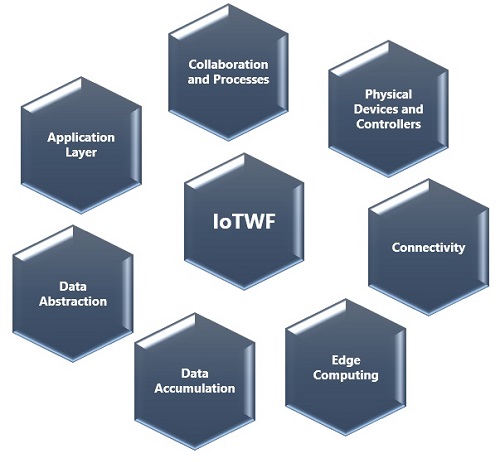Home »
IoT (Internet of Things) Tutorial
The IoT World Forum (IoTWF) Standardized Architecture
In this tutorial, we will learn about the IoT World Forum (IoTWF) standardized architecture and its layers.
By Shahnail Khan Last updated : August 12, 2023
The IoT World Forum (IoTWF) Standardised Architecture is a set of rules that enable those who deal with the Internet of Things (IoT) to accomplish their jobs better. These recommendations were developed in 2014 by a consortium of large corporations, including Cisco and IBM. These guidelines are super important in the IoT world because they provide a way for people to create and connect IoT systems. It's like having a map to build and grow IoT projects, making them work well together and making it easier for everyone to use.
IoTWF architecture consists of seven layers, each layer specifying a different purpose.
The seven layers of the IoTWF Standardized Architecture include -

Fig: IoTWF Architecture
1. Physical Devices and Controllers (Things)
These are the actual "things" of the Internet of Things. These might be physical assets such as machines or equipment. These "things" in the tech sector might also be sensors and devices linked to these assets. Although they may not yet have sensors, we are heading towards increasingly interconnected systems.
2. Connectivity
This layer bridges the gap between the Edge Node device and the cloud, ensuring that the data can run smoothly. It is an important aspect since it ensures that data from the field may reach its destination in the cloud or on-premise. This layer functions as a transportation system for your IoT data, and it may take various routes, such as highways or backroads, to deliver your data where it needs to go.
3. Edge Computing
This layer, also known as "Cloud Edge" or "Cloud Gateway" computing, is crucial in any IoT system. Edge computing is a type of computing that occurs at or near the network's edge/at the device layer. Several important tasks take place in this layer –
- Protocol conversion - Protocol conversion is similar to having a translator ensure that data speaks the correct language while flowing between different portions of the IoT system.
- Routing - Consider routing to be traffic control. It routes data to the appropriate locations for processing and analysis.
- Fast Decision-Making - This layer is likewise in charge of making rapid decisions to keep things operating smoothly and with low delays.
4. Data Accumulation
IoT systems create large amounts of data, and this layer acts as a data storage warehouse. It is necessary since this layer stores incoming data and prepares data for future processing. Once the data is ready, it is sent to the next levels for analysis and decision-making.
5. Data Abstraction
We're finally making sense of the data. We collect similar data from a variety of sources, prioritise critical information, and prepare data for a variety of applications.
6. Application Layer
The Application Layer is where the real action happens. It's fairly simple, and here's what it does:
- Control and Data Logic - Consider this layer to be the control centre for your IoT system. It's where all the smart decisions are made.
- Wide Range of Functions - This layer performs a wide range of functions, including monitoring how everything works, optimising processes to improve them, managing alarms when something goes wrong, analysing data to find important patterns, setting up control rules, and even handling logistics and understanding consumer behaviour.
7. Collaboration and Processes
Finally, this layer integrates everything. It is the point at which individuals engage with the IoT system. Data and apps are used to make choices, optimise operations, and generate value. This layer connects technology to real-world advantages such as enhancing businesses or improving our lives.
Conclusion
We can accomplish some significant things with this model:
- We can divide the complex IoT challenge into smaller, more manageable components. It's similar to slicing a large pizza into slices to make it easier to consume.
- We can examine the many technologies employed at each phase and their interaction. It's just like knowing the ingredients needed for each part of a recipe.
- We may create our IoT system using components from several vendors. It's like designing a car with one company's engine and another's tires.
- We can devise a security strategy to ensure the safety of our IoT system. It's similar to having closed doors at different areas of a building's entrances to keep unwanted people out.
Advertisement
Advertisement